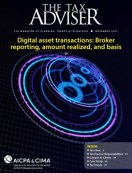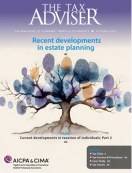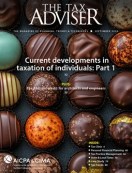- tax clinic
- expenses & deductions
Comparing and contrasting business tax strategies
Related
Two Tax Court rulings expose overvalued conservation easements
Company’s $1.6 billion ‘break fee’ payment treated as ordinary deduction
IRS ruling clarifies treatment of R&D when computing the FDII deduction
TOPICS
Editor: Jessica L. Jeane, J.D.
Businesses can significantly reduce their tax burden by strategically utilizing available deductions related to real and personal property. This item dives deep into the tax–saving strategies of de minimis deductions, tangible property repairs and maintenance (R&M), Sec. 179 expensing, qualified improvement property (QIP), and partial asset disposal. Understanding the nuances of these tax rules is crucial to obtaining maximum benefits for taxpayers.
De minimis safe-harbor election
The simplest strategy allows taxpayers to elect to expense the amount paid to acquire or produce tangible property where the amount is expensed for GAAP financial statement purposes. Taxpayers with a written accounting policy providing for expensing as of the beginning of the tax year can deduct amounts paid for items costing up to $2,500 per invoice or item, or $5,000, for companies treating them as an expense on an applicable financial statement (Regs. Sec. 1.263(a)-1(f)(1)(i)). Both financial statements and tax reporting must follow this method.
Example 1: A client sends an invoice for $100,000 for 50 computers. The total invoice exceeds the $2,500 threshold, but per item, the computers are $2,000 a unit and can be immediately expensed if the terms of the capitalization policy allow.
Often, when taxpayers look through tax asset depreciation schedules, they find many items on the schedule are under the allowed thresholds. Applying the de minimis safe–harbor election not only increases tax deductions but simplifies depreciation schedules.
The election is made annually by attaching a statement titled “Section 1.263(a)-1(f) de minimis safe harbor election” to the tax return. De minimis safe–harbor deductions are not subject to Sec. 1245 ordinary–income recapture upon sale.
R&M expense
An R&M expense includes noncapitalizable, immediately deductible expenditures that keep property in habitable and working condition without meeting thresholds to be considered an improvement, which is defined as a betterment, restoration, or adaptation to a new or different use. R&M can be applied to machinery and equipment but has the greatest impact on real property.
There is no bright–line test for whether an expenditure is a betterment, restoration, or adaptation. The facts and circumstances of each capital expenditure must be evaluated on a case–by–case basis. The taxpayer must look at each unit of property (UOP) placed in service to determine whether the expenditure must be capitalized as an improvement, based, in part, on the examples of improvements below (Regs. Secs. 1.263(a)-3(j) and (l)):
- A taxpayer repairs a known defect that existed prior to purchasing the UOP or arose during the production of the UOP.
- The improvement increases productivity, efficiency, strength, quality, or output of the UOP.
- The improvement is a material addition to the UOP.
- The improvement returns the UOP to its ordinarily efficient operating condition after the property had deteriorated to a state of disrepair and was no longer functional for its intended use. This improvement results in the rebuilding of the UOP to a like-new condition after the end of its class life or is for the replacement of a part or a combination of parts that comprise a major component or a substantial structural part of the UOP.
- The improvement adapts a UOP to a new or different use that is inconsistent with ordinary use of the UOP at the time it was originally placed in service by the taxpayer.
For the avoidance of doubt, if one of the above definitions is met, the expenditure must be capitalized and depreciated. If none of the above criteria are met, the expenditure can be immediately deducted.
The routine–maintenance safe harbor allows amounts paid for routine maintenance on a UOP to not be capitalized as an improvement (Regs. Sec. 1.263(a)-3(i)). This includes recurring activities to a building UOP that a taxpayer reasonably expects to perform more than once during the 10–year period beginning on the date placed in service, in order to keep (as opposed to put) the building structure or each building system in its ordinarily efficient operating condition. For UOPs other than buildings, the taxpayer must reasonably expect to perform the activities more than once during the class life of the UOP.
A UOP for a building is composed of the building and its structural components. However, taxpayers must apply the improvement standards separately to the building structure and to each specifically defined building system. Building systems are defined to include HVAC systems, plumbing systems, electrical systems, all escalators as one system, all elevators as one system, fire protection and alarm systems, security systems, gas distribution systems, and any other systems identified in published guidance (Regs. Sec. 1.263(a)-3(e)). A UOP is a crucial concept when determining whether an expenditure is a deductible expense or capital improvement that must be depreciated.
To understand the application of the UOP in an R&M analysis, consider the example of replacing one HVAC unit and testing it only against the HVAC system rather than the entire building. If there is only one HVAC unit in the building and it is replaced, that HVAC replacement is likely an improvement to the overall UOP (the HVAC system) and needs to be capitalized. In contrast, if one of four HVAC units is replaced in the building, then it is unlikely to be an improvement when compared to the overall UOP and is most likely a deductible R&M expense.
Roof cover replacement is a frequent example presented in the R&M regulations (e.g., Regs. Sec. 1.263(a)-3(k)(7), Examples (14) and (15)). If a building is purchased with a roof that did not need replacement immediately and, later, the membrane or asphalt roof is replaced with a similar membrane or asphalt roof to keep the UOP in its ordinarily efficient operating condition, it is not a betterment. The full cost of the expenditure can be deducted immediately. In addition to currently deducting the new roof cover replacement, the old roof’s basis continues to depreciate. Conversely, if substantial deck and truss repair under the membrane or asphalt roof is completed such that the improvement increases productivity, efficiency, strength, quality, or output of the UOP, then the roof must be capitalized and depreciated. The taxpayer can take a partial asset disposal of the old roof that was replaced if there is still basis for it on the depreciation schedule (see below for partial asset disposal). Questions often arise in this area because roof expenditures can be significant. Therefore, it is important to remember that cost is not the driving factor but rather the impact of placing the repair or improvement in service.
Like de minimis expensing, R&M is not subject to Sec. 1245 ordinary–income recapture upon sale because repairs do not increase the cost basis. Therefore, they do not affect the calculation of capital gain when the property is sold. The capital gain is based on the sale price minus the adjusted cost basis (which does not include the cost of the repair). The R&M regulations have been around since 2014 and are often overlooked for simpler bonus depreciation and/or Sec. 179 expensing. However, taxpayers can avoid ordinary–income recapture by taking a closer look at the R&M rules. In addition, real property can receive R&M treatment but not the benefits of bonus depreciation.
No election or form needs to be filed with the tax return to allow for R&M expense.
Sec. 179 expensing
Sec. 179 expensing is a way for small or medium–size businesses to capitalize and immediately deduct expenditures up to an annual limit on new or used equipment utilized in an active trade or business. As a result, residential property does not qualify for Sec. 179 expensing, nor does property owned by trusts and estates (except for grantor trusts). Nonresidential tangible property that does qualify includes manufacturing equipment and machinery, business vehicles (although there are some special rules for these), computers and office technology, off–the–shelf software, office furniture and equipment, and certain building improvements.
Considerations:
- Annual limits: The deduction limit is subject to annual caps, which may not cover all capital expenditures put into service in a given year. Prior to the enactment of the law commonly known as the One Big Beautiful Bill Act (OBBBA), H.R. 1, P.L. 119-21, for 2025, the cap on annual qualifying expenditures for eligible businesses was $1,250,000. Under the act, it increased to $2.5 million for property placed in service after 2024.
- Phaseout threshold: The benefit phases out for businesses with capital expenditures exceeding a certain amount set annually by the IRS, limiting its applicability for larger operations. Prior to the act, for 2025, the phaseout began when annual expenditures exceeded $3,130,000. Under the act, it increased to $4 million for property placed in service after 2024.
- Asset use: Qualifying assets must be used for business purposes more than 50% of the time at all times.
Prior to the enactment of the Tax Cuts and Jobs Act (TCJA), P.L. 115–97, Sec. 179 expensing was allowed only on new equipment. Since the TCJA, used equipment can also qualify. In addition, the TCJA allowed expensing on building capital improvements such as roofs, HVAC equipment, QIP, fire protection, security systems, and fire alarms. The addition of roof covers and HVAC equipment is noteworthy because it provides an opportunity for deducting this expenditure where the roof replacement is a betterment or material structural work has occurred and therefore does not qualify as R&M. It still can qualify for Sec. 179 expensing after the expenditure has been capitalized.
When a business is subject to the phaseout threshold for Sec. 179, it should start implementing other tax strategies in addition. Unlike de minimis and R&M expenses, Sec. 179 expensing is subject to recapture upon the sale of the equipment or building.
Example 2: Equipment is purchased for $30,000, and the full $30,000 of Sec. 179 expense is taken in year 1, with a resulting adjusted basis of $0. If the equipment is sold in year 3 for $15,000, the gain on the sale is $15,000 ($15,000 sale price – $0 adjusted basis). The recapture amount would be the lesser of the gain ($15,000) or the original deduction ($30,000), which is $15,000. This means $15,000 is reported as ordinary income in the year of the sale.
Sec. 179 expense is reported on Form 4562, Depreciation and Amortization (Including Information on Listed Property), with the tax return. No further elections must be filed with the return.
Qualified improvement property
QIP includes interior and nonstructural improvements to an existing nonresidential building that are too significant to qualify as repairs. Common examples include replacing the flooring in a large percentage of a building, retrofitting all nondecorative lighting for energy efficiency, replacing a significant portion of an HVAC system, adapting existing space for a new or different use, reconfiguring space to materially improve productivity, or upgrading electrical systems to materially increase energy efficiency. QIP can be located in buildings that are leased or owned.
Prior to passage of the Coronavirus Aid, Relief, and Economic Security (CARES) Act, P.L. 116–136, in 2020, QIP was capitalized 39–year property ineligible for bonus depreciation. However, the CARES Act changed QIP to capitalized 15–year property eligible for bonus depreciation under the general depreciation system or 20–year property under the alternative depreciation system.
It is important to emphasize that QIP does not include exterior improvements to a building (e.g., land improvements, roofs, or building façade) or improvements to an elevator or escalator system. Nor does it include structural work. R&M or Sec. 179 expensing should be utilized, if possible, for the types of expenditures that do not qualify as QIP.
QIP should be capitalized only after determining that the project does not qualify for R&M expense because it meets the betterment, restoration, or adaptation definitions of an improvement. Even though, under the new legislation, bonus depreciation returns to 100% for qualified property placed in service after Jan. 19, 2025, QIP is not immediately deductible in states that do not follow federal depreciation. Therefore, treating a remodeling project as R&M rather than QIP may be more beneficial. Still, like property expensed under Sec. 179, QIP can be subject to ordinary–income recapture under Sec. 1245 or 1250, along with unrecaptured Sec. 1250 gain.
QIP depreciation is reported on Form 4562 with the tax return. No further elections must be filed with the return.
Partial asset disposal
Sometimes, capitalization and depreciation is the only answer for a fixed–asset addition. The good news is that a partial asset disposal is available to write off the remaining basis of the original asset if the entire asset or part of the asset has been replaced by a new depreciable asset. On occasion, it can be as easy as identifying the asset on the tax fixed–asset ledger and disposing of it. Other times, it will take some effort to value the remaining basis of the disposed asset or partially disposed asset. Three acceptable methods for determining the value are:
- Pro rata allocation: This is the allocation of the original asset’s depreciable basis, based on the replacement cost of the disposed portion and the replacement cost of the entire asset.
- Producer price index: If the replacement portion is a restoration and is not a betterment or an adaptation to a new or different use, taxpayers can discount the cost of the replacement portion of the asset to its placed-in-service year cost using the appropriate producer price index. The producer price index works backward from the replacement cost, adjusting for inflation.
- Cost segregation study: Performing a cost segregation study and identifying the units of property placed in service from the original acquisition is the most accurate method to determine the value of the disposed asset. Filing a Form 3115, Application for Change in Accounting Method, for a change in accounting method may be necessary if the asset was not acquired in the current year.
QIP can be claimed along with partial asset disposals. This creates a permissible “double dip” tax benefit for the taxpayer from both the deduction of disposed asset basis and the deduction of improvement property placed in service.
The election for a partial disposition is made according to Regs. Sec. 1.168(i)-8(d)(2)(ii) and included in the tax return.
Optimizing deductions
This item provides a refresher for fixed–asset options that can assist taxpayers in optimizing deductions for asset recovery. Multitiered strategies that can incorporate some or all of these options can create the most useful tax benefit for taxpayers.
Editor
Jessica L. Jeane, J.D., is director of tax policy, national tax, with Baker Tilly in McLean, Va.
For additional information about these items, contact Jeane at Jessica.Jeane@bakertilly.com.
Contributors are members of or associated with Baker Tilly.
Baker Tilly US, LLP, and Baker Tilly Advisory Group, LP, and its subsidiary entities provide professional services through an alternative practice structure in accordance with the AICPA Code of Professional Conduct and applicable laws, regulations, and professional standards. Baker Tilly US, LLP, is a licensed independent CPA firm that provides attest services to clients. Baker Tilly Advisory Group, LP, and its subsidiary entities provide tax and business advisory services to their clients. Baker Tilly Advisory Group, LP, and its subsidiary entities are not licensed CPA firms.














